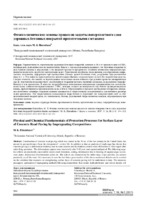Физико-химические основы процессов защиты поверхностного слоя дорожных бетонных покрытий пропиточными составами
Another Title
Physical and Chemical Fundamentals of Protection Processes for Surface Layer of Concrete Road Paving by Impregnating Compositions
Bibliographic entry
Пшембаев, М. К. Физико-химические основы процессов защиты поверхностного слоя дорожных бетонных покрытий пропиточными составами = Physical and Chemical Fundamentals of Protection Processes for Surface Layer of Concrete Road Paving by Impregnating Compositions / М. К. Пшембаев // Наука и техника. – 2017. – № 2. - С. 144–152.
Abstract
Перспективность строительства дорожных бетонных покрытий, начатого в 30-е гг. прошлого века в США, подтверждена долговечностью их эксплуатации. Вместе с тем исследования показывают, что бетонные покрытия по ряду причин склонны к деформации, а это вызывает трудности при ремонте. Особенно интенсивно деформации проявляются после пяти–десяти лет эксплуатации дорог. Практически неизбежны такие явления, как образование микротрещин, шелушение, деформации при промерзании угловых граней бетонных плит, разрушение деформационных швов и т. д. Эти дефекты характеризуются значительным объемом и присутствуют на всех без исключения дорогах.
Следует отметить, что многих из перечисленных недостатков можно избежать при условии принятия своевременных мер по упрочнению поверхностного слоя бетонного покрытия методом пропитки составами, содержащими гидрофобизатор и золь кремнезема. В качестве гидрофобизатора использовали выпускаемые промышленностью метилсиликонат калия, олигометилгидридсиликонат, ТЭОС, которые создают на поверхности пор бетона труднорастворимую пленку, препятствующую проникновению воды в бетон. Образующийся в процессе растворения и гидролиза минералов цементного клинкера гидроксид кальция связывается в гидросиликаты содержащимся в пропитанном растворе золем кремнезема. Эти гидросиликаты кальматируют поры бетона и упрочняют его поверхностный слой за счет дополнительной твердой фазы, по химическому составу родственной гидросиликатам кальция, образующимся при твердении цемента.
Abstract in another language
Construction of concrete road paving which was started in the 30-ies of the last century in the United States has proved its perspectiveness from the viewpoint of service life. In addition to that an analysis of road usage has shown that concrete paving is a deformation tendency due to some reasons and the tendency entails some difficulties in their repair after rather long operation. The deformations appear more intensively after 5-10-year road operational period. The following negative effects are practically unavoidable: micro-crack formation, scaling, deformation due to freezing of angular edges in concrete plates, destruction of deformation joints etc. The defects are characterized by rather large scope and they are present practically on all the roads. It is necessary to note the fact that a great number of the above-mentioned defects can be avoided on the condition that measures on strengthening surface layer of concrete paving will be undertaken in time. The measures presuppose application of impregnating method while using compositions that contain hydrophobisator and silicon dioxide sol. Industry-produced potassium methyl siliconate, oligomethyl hydride siliconate, tetraethoxysilane have been used as hydrophobisator and they form not easily soluble film on the surface of concrete pores which prevents penetration of water into concrete. Calcium hydrate being formed in the dissolution and hydrolysis process of cement clinker minerals is bound in hydrosilicates which are contained in the solution impregnated by silicon dioxide sol. These hydrosilicates culmatate concrete pores and strengthen its surface layer due to additional hard phase and according to chemical composition it is related to
calcium hydrosilicates formed as a result of concrete hardening.
View/
Collections
- №2[11]

